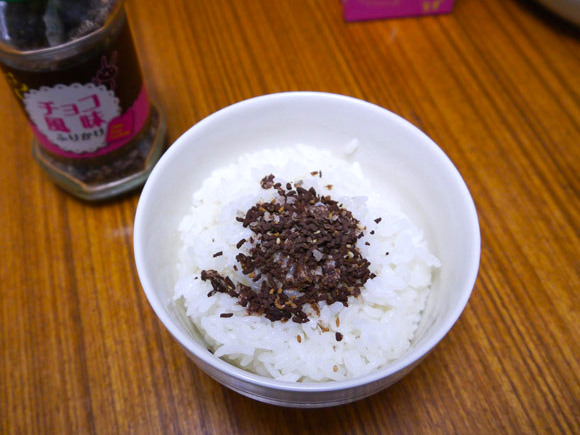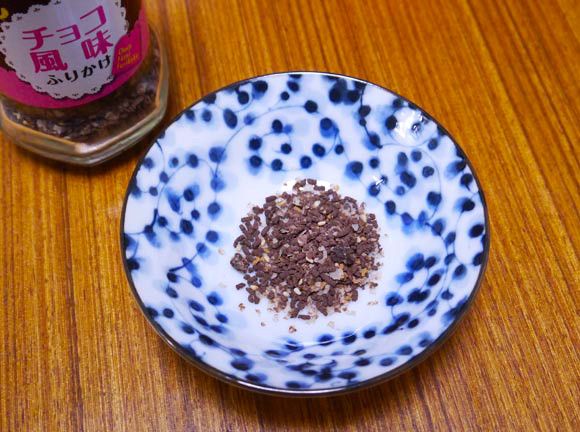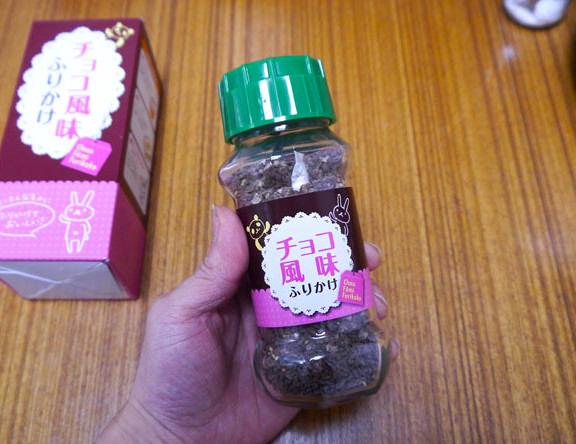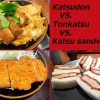
Until recently, rice-loving Americans looking to add a little zing to their favorite grain would need to trek out to the nearest Asian grocery store to pick up a pack of furikake rice topping. But now, according to Japanese media, the toppings are gaining traction on the US west coast and is becoming more widely available.
Furikake consists of a mish-mash of ingredients that have been dried and powdered and, in Japan, is intended specifically and only to be sprinkled atop a steaming hot bowl of sticky Japanese rice; which explains why many Japanese people are reacting with shock at how the Americans are choosing to deploy the condiment.
Japanese news compilation site Naver Matome has gathered a handful of anecdotes from news, blogs, and tweets which claim that, while furikake is gaining more widespread acceptance in the United States, many consumers appear to be using it for sprinkling onto all kinds of different foods that are objectively not white rice.
For starters, it seems that one of the many uses of furikake stateside is as a rub or garnish on things like grilled chicken and seared meats. Additionally, some are even sprinkling it on hot dogs, spam (this is probably referring to spam musubi, the popular Hawaiian/Japanese snack), hamburgers and french fries, popcorn, pastas and salads.
Some Netizens in Japan are pretty happy about furikake’s spread in America, not least because it means they’ll be able to get their hands on it more easily when abroad. Others, however, were disgruntled by the many American recipes that seemed to break the “rules” of furikake use.
Generally speaking, sticky Japanese white rice is unsurprisingly revered in Japan. It’s the staple food of the country and it’s served on the side with most meals. Since most Japanese have enjoyed bowls of fluffy, steamed white rice with nearly every meal since childhood, many consider it an almost perfect foodstuff, not to be defiled by additional flavors and additives, unless said additives or toppings have subtle, complementary flavors. This is why a lot of Japanese people turn up their noses at westerners, who have a perceived tendency to pour soy sauce over their rice.
A Japanese bottle of chocolate furikake, unusual even by Japanese standards
But here’s the rub: if Japanese white rice is such a perfect dish meant to be enjoyed by itself, then why is furikake paradoxically okay on only the one food you’re not supposed to add flavors to? The stuff comes in all kinds of wacky varieties, like wasabi, the above-pictured chocolate, ume plum, bonito… it’s basically just funhouse salt and it’s great. There ought to be a million uses for the stuff, so go America! Heck, put it on your morning Count Chocula cereal if the mood strikes you; I won’t judge. The whole point of food—other than, I guess, that whole keeping you alive thing—is to taste good to the individual consumer, after all…
Source: Naver Matome
Images: RocketNews24



 Japan’s potato chip-flavor rice topping is set to add some snack-time appeal to plain white rice
Japan’s potato chip-flavor rice topping is set to add some snack-time appeal to plain white rice Sushi and onigiri rice balls get a new look with rollable furikake
Sushi and onigiri rice balls get a new look with rollable furikake Neco Meshi: The line of Japanese snacks that both you and your cat can eat! 【Taste test】
Neco Meshi: The line of Japanese snacks that both you and your cat can eat! 【Taste test】 Fried chicken-flavor rice spread going on sale in Japan to keep your karaage cravings satisfied
Fried chicken-flavor rice spread going on sale in Japan to keep your karaage cravings satisfied Nissin Cup Noodle flavored seasoning for rice?!?
Nissin Cup Noodle flavored seasoning for rice?!? McDonald’s new Happy Meals offer up cute and practical Sanrio lifestyle goods
McDonald’s new Happy Meals offer up cute and practical Sanrio lifestyle goods Studio Ghibli releases new action figures featuring Nausicaä of the Valley of the Wind characters
Studio Ghibli releases new action figures featuring Nausicaä of the Valley of the Wind characters Studio Ghibli glasses cases let anime characters keep an eye on your spectacles
Studio Ghibli glasses cases let anime characters keep an eye on your spectacles All-you-can-drink Starbucks and amazing views part of Tokyo’s new 170 meter-high sky lounge
All-you-can-drink Starbucks and amazing views part of Tokyo’s new 170 meter-high sky lounge Katsudon vs. tonkatsu vs. katsu sandwich – What’s the best way to eat pork cutlet in Japan?
Katsudon vs. tonkatsu vs. katsu sandwich – What’s the best way to eat pork cutlet in Japan? We try out “Chan Ramen”, an underground type of ramen popular in the ramen community
We try out “Chan Ramen”, an underground type of ramen popular in the ramen community McDonald’s Japan releases a pancake pie for new retro kissaten coffeeshop series
McDonald’s Japan releases a pancake pie for new retro kissaten coffeeshop series Kyoto’s 100 Demons yokai monster parade returns!
Kyoto’s 100 Demons yokai monster parade returns! Is the all-you-can-eat KFC buffet in Tokyo really as good as they say it is?
Is the all-you-can-eat KFC buffet in Tokyo really as good as they say it is? Arrest proves a common Japanese saying about apologies and police
Arrest proves a common Japanese saying about apologies and police More foreign tourists than ever before in history visited Japan last month
More foreign tourists than ever before in history visited Japan last month Disney princesses get official manga makeovers for Manga Princess Cafe opening in Tokyo
Disney princesses get official manga makeovers for Manga Princess Cafe opening in Tokyo Starbucks reopens at Shibuya Scramble Crossing with new look and design concept
Starbucks reopens at Shibuya Scramble Crossing with new look and design concept Beautiful new Final Fantasy T-shirt collection on the way from Uniqlo【Photos】
Beautiful new Final Fantasy T-shirt collection on the way from Uniqlo【Photos】 Is the new Shinkansen Train Desk ticket worth it?
Is the new Shinkansen Train Desk ticket worth it? Foreign English teachers in Japan pick their favorite Japanese-language phrases【Survey】
Foreign English teachers in Japan pick their favorite Japanese-language phrases【Survey】 Beautiful Sailor Moon manhole cover coasters being given out for free by Tokyo tourist center
Beautiful Sailor Moon manhole cover coasters being given out for free by Tokyo tourist center Studio Ghibli releases Kiki’s Delivery Service chocolate cake pouches in Japan
Studio Ghibli releases Kiki’s Delivery Service chocolate cake pouches in Japan Japan’s bone-breaking and record-breaking roller coaster is permanently shutting down
Japan’s bone-breaking and record-breaking roller coaster is permanently shutting down New definition of “Japanese whiskey” goes into effect to prevent fakes from fooling overseas buyers
New definition of “Japanese whiskey” goes into effect to prevent fakes from fooling overseas buyers Our Japanese reporter visits Costco in the U.S., finds super American and very Japanese things
Our Japanese reporter visits Costco in the U.S., finds super American and very Japanese things Studio Ghibli unveils Mother’s Day gift set that captures the love in My Neighbour Totoro
Studio Ghibli unveils Mother’s Day gift set that captures the love in My Neighbour Totoro Domino’s Japan now sells…pizza ears?
Domino’s Japan now sells…pizza ears? New Japanese KitKat flavour stars Sanrio characters, including Hello Kitty
New Japanese KitKat flavour stars Sanrio characters, including Hello Kitty One of Tokyo’s most famous meeting-spot landmarks is closing for good
One of Tokyo’s most famous meeting-spot landmarks is closing for good Kyoto creates new for-tourist buses to address overtourism with higher prices, faster rides
Kyoto creates new for-tourist buses to address overtourism with higher prices, faster rides Sales of Japan’s most convenient train ticket/shopping payment cards suspended indefinitely
Sales of Japan’s most convenient train ticket/shopping payment cards suspended indefinitely Sold-out Studio Ghibli desktop humidifiers are back so Totoro can help you through the dry season
Sold-out Studio Ghibli desktop humidifiers are back so Totoro can help you through the dry season Japanese government to make first change to romanization spelling rules since the 1950s
Japanese government to make first change to romanization spelling rules since the 1950s Ghibli founders Toshio Suzuki and Hayao Miyazaki contribute to Japanese whisky Totoro label design
Ghibli founders Toshio Suzuki and Hayao Miyazaki contribute to Japanese whisky Totoro label design Doraemon found buried at sea as scene from 1993 anime becomes real life【Photos】
Doraemon found buried at sea as scene from 1993 anime becomes real life【Photos】 Tokyo’s most famous Starbucks is closed
Tokyo’s most famous Starbucks is closed One Piece characters’ nationalities revealed, but fans have mixed opinions
One Piece characters’ nationalities revealed, but fans have mixed opinions We asked a Uniqlo employee what four things we should buy and their suggestions didn’t disappoint
We asked a Uniqlo employee what four things we should buy and their suggestions didn’t disappoint Princesses, fruits, and blacksmiths: Study reveals the 30 most unusual family names in Japan
Princesses, fruits, and blacksmiths: Study reveals the 30 most unusual family names in Japan Nicocafe dishes up a serving of surreal with manga meat, half an umaibo, and rice teishoku
Nicocafe dishes up a serving of surreal with manga meat, half an umaibo, and rice teishoku New traditional rice topping selling well, but at 10,000 yen a pop it doesn’t take much
New traditional rice topping selling well, but at 10,000 yen a pop it doesn’t take much How many do you know? 12 delicious foods in Japanese supermarkets and convenience stores
How many do you know? 12 delicious foods in Japanese supermarkets and convenience stores Japan has an awesome one-person bento box rice cooker, and here’s what we made with ours
Japan has an awesome one-person bento box rice cooker, and here’s what we made with ours Japan’s ideas for easy meals that rely on one wonder ingredient: cheese!
Japan’s ideas for easy meals that rely on one wonder ingredient: cheese! “Let them eat furikake!” says Mayor Hashimoto as Osaka school lunch saga rumbles on
“Let them eat furikake!” says Mayor Hashimoto as Osaka school lunch saga rumbles on This Robo Chef will make you perfect fried rice without any need to lift a heavy wok
This Robo Chef will make you perfect fried rice without any need to lift a heavy wok Turns out that mochi can be made more delicious by smothering it in creamy carbonara sauce
Turns out that mochi can be made more delicious by smothering it in creamy carbonara sauce Japanese pork cutlet chain unveils its latest fusion food: cornflake chicken katsu bowls!
Japanese pork cutlet chain unveils its latest fusion food: cornflake chicken katsu bowls! The best-selling rice ball at Family Mart is…SPAM onigiri?
The best-selling rice ball at Family Mart is…SPAM onigiri? Onigiri without the nigiri – Japan’s traditional rice balls get an update
Onigiri without the nigiri – Japan’s traditional rice balls get an update New magic powder purports to make natto edible even for bean-haters
New magic powder purports to make natto edible even for bean-haters PewDiePie tries “every” Japanese snack and this is how people in Japan reacted to it
PewDiePie tries “every” Japanese snack and this is how people in Japan reacted to it Survey reveals the top five times Japanese travelers realise just how Japanese they are
Survey reveals the top five times Japanese travelers realise just how Japanese they are Okinawan soul fool Pork Tamago Onigiri sold not at a five-star restaurant, but at an airport
Okinawan soul fool Pork Tamago Onigiri sold not at a five-star restaurant, but at an airport
Leave a Reply